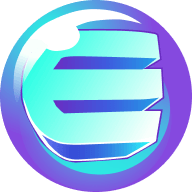What’s Enjin Coin (ENJ)? How can I buy it?
What is Enjin Coin?
Enjin Coin (ENJ) is a digital asset designed to power blockchain-based gaming, NFTs, and digital economies. Launched by Enjin, a company founded in 2009 known for building gaming community tools, ENJ was introduced via an ERC-20 token in 2017 to back and manage blockchain assets within the Enjin ecosystem. At its core, ENJ gives tangible, programmable value to digital items—such as in-game assets, artwork, collectibles, and loyalty rewards—by “backing” them with a reserve of ENJ.
Enjin’s suite includes tools for minting NFTs, managing digital inventories, integrating crypto into games and apps, and operating marketplaces. Over time, Enjin expanded beyond Ethereum to include cross-chain capabilities and its own Substrate-based blockchain, Enjin Blockchain, optimized for NFTs and on-chain assets, while still maintaining compatibility with established standards.
Key purpose of ENJ:
- Collateral for NFTs: Creators lock ENJ into assets at minting, giving items intrinsic value and enabling straightforward redemption.
- Economic alignment: ENJ’s lock-up model potentially constrains circulating supply as more assets are minted.
- Utility in ecosystem: Used for fees (depending on chain), governance features in certain contexts, and as a medium of value across Enjin-powered apps and marketplaces.
How does Enjin Coin work? The tech that powers it
Enjin’s technology stack is built to make NFT and asset management accessible to developers and users without deep blockchain expertise. It spans standards, wallets, SDKs, and an NFT-centric blockchain infrastructure.
Core components:
-
Token and NFT standards:
- ENJ initially launched as an ERC-20 token on Ethereum.
- Enjin developed ERC-1155 (co-authored by Enjin CTO Witek Radomski), a widely adopted multi-token standard on Ethereum. ERC-1155 allows a single smart contract to represent both fungible and non-fungible tokens efficiently, reducing gas costs and simplifying asset management.
- Enjin’s newer infrastructure introduces Efinity/Enjin standards on its Substrate-based chain for scalable NFT operations.
-
Minting with ENJ backing:
- Asset creators define an asset (e.g., an in-game sword, membership badge, or collectible) and lock a set amount of ENJ into it at mint time.
- The locked ENJ serves as collateral and can be “melted” (redeemed) by destroying the asset, returning the ENJ to the holder subject to protocol rules and fees. This mechanism ties digital item scarcity and value to a tangible crypto reserve.
-
Enjin Wallet and Wallet SDK:
- The Enjin Wallet (mobile) supports ENJ and NFTs, enabling users to store, trade, and interact with assets across supported networks.
- SDKs for Unity, Java, and other environments help developers integrate blockchain features (minting, trading, inventories, player wallets) directly into games and apps.
-
Marketplaces and Beam:
- Enjin Marketplace allows listing and trading of Enjin-backed NFTs.
- Enjin Beam lets creators distribute NFTs via QR codes, enabling frictionless claims in marketing campaigns, events, and games.
-
Enjin Blockchain (and Efinity history):
- Enjin originally developed Efinity on Polkadot for NFT scalability and low fees. The project evolved into Enjin Blockchain, a Substrate-based chain purpose-built for NFTs and digital assets, with features like native NFT support, efficient transfers, and customizable economics for apps.
- Cross-chain bridges and interoperability hooks connect Enjin Blockchain with Ethereum and other ecosystems so assets can move, be mirrored, or wrapped where liquidity and users reside.
-
Economic design and fees:
- On Ethereum, actions like minting or transferring assets incur gas fees in ETH; Enjin’s ERC-1155 efficiencies help reduce costs compared to ERC-721-only approaches.
- On Enjin Blockchain, fees are designed to be lower and more predictable, often enabling better user experiences (e.g., meta-transactions or sponsored fees by developers).
Security and governance:
- Smart contract audits and open standards increase transparency.
- The backing-and-melting mechanism relies on audited contracts to ensure locked ENJ reserves correspond to minted assets.
- Network-level security on Enjin Blockchain follows Substrate consensus mechanisms, with validators securing the chain.
What makes Enjin Coin unique?
- ENJ-backed NFTs as a value layer: By embedding ENJ as collateral in every minted item, Enjin ties digital assets to a base value, which can improve user confidence and create a floor price dynamic for items.
- ERC-1155 pioneer: Enjin co-authored ERC-1155, now a dominant NFT and multi-token standard across Ethereum and EVM chains, providing efficiency and batch operations that many NFT platforms rely on.
- End-to-end developer stack: From SDKs and wallet integrations to QR-code distribution (Beam) and marketplaces, Enjin offers a full pipeline for onboarding users and building Web3 apps with minimal friction.
- Purpose-built NFT chain: Enjin Blockchain focuses on digital goods throughput, low fees, and user experience, addressing Ethereum’s congestion challenges while maintaining cross-chain interoperability.
- Gaming-native DNA: Enjin’s roots in gaming communities inform a practical product design ethos centered on user experience, inventory systems, and digital ownership mechanics that feel familiar to players.
Enjin Coin price history and value: A comprehensive overview
Note: Crypto markets are volatile. Always verify current data using reputable aggregators and exchanges.
Historical context:
- Launch and early years (2017–2020): ENJ traded in line with broader crypto cycles, gaining visibility as Enjin announced partnerships and advanced ERC-1155 adoption.
- 2021 bull cycle: ENJ experienced significant appreciation amid NFT and metaverse narratives, listings on major exchanges, and progress on Efinity. Prices reached all-time highs during this period as attention to gaming/NFT tokens surged.
- 2022–2023 bear market: Like many altcoins, ENJ retraced substantially as liquidity tightened, risk appetite fell, and NFT trading volumes declined. Focus shifted to fundamentals, shipping infrastructure, and chain development.
- 2024–2025 developments: Enjin advanced its dedicated NFT chain strategy and ecosystem tooling. ENJ’s performance reflected macro crypto trends, risk sentiment, and adoption of Enjin’s tools and chain.
Value drivers to watch:
- Network usage: Growth in minted assets, active users, and transaction volumes across Enjin Blockchain and Ethereum.
- Developer adoption: Integration of Enjin SDKs by games and brands; partnerships for large-scale NFT programs.
- Liquidity and listings: Depth on major exchanges and cross-chain bridges that reduce friction for users and developers.
- Broader NFT/gaming cycles: Recovery or expansion in NFT volumes, Web3 gaming adoption, and brand activations.
- Token economics: ENJ lock-ups in minted assets versus melting dynamics, and any changes to fee models or chain-level incentives.
Risks:
- Competitive landscape: Strong competition from other gaming/NFT platforms and L2s.
- Execution and network effects: Sustained developer traction and user onboarding are critical.
- Regulatory uncertainty: Digital asset and NFT regulations vary by jurisdiction and may affect operations or demand.
Is now a good time to invest in Enjin Coin?
This depends on your risk tolerance, time horizon, and thesis about Web3 gaming and NFTs.
Considerations:
- Fundamental thesis: If you believe digital ownership will be integral to gaming and brand engagement, Enjin’s infrastructure approach—especially ENJ-backed assets and developer-friendly tooling—aligns with that narrative.
- Adoption metrics: Monitor active projects on Enjin, on-chain activity, NFT minting rates, and SDK adoption. Rising fundamentals can support a longer-term investment case.
- Market regime: Crypto markets are cyclical. Buying during broader risk-off periods can offer better long-term entries, but prices can remain volatile. Dollar-cost averaging may mitigate timing risk.
- Diversification: Given sector-specific risks, consider diversifying across infrastructure, gaming tokens, and broader crypto assets.
- Research and security: Use reputable sources (project documentation, code repos, independent audits, and major data providers). Store assets securely, ideally with a hardware wallet compatible with ENJ and relevant networks.
None of this is financial advice. Conduct independent research, evaluate your portfolio strategy, and consider consulting a licensed financial advisor.
Sources and references for further research:
- Enjin official documentation and blog
- ERC-1155 standard (Ethereum Improvement Proposals repository)
- Enjin Wallet and SDK docs
- Enjin Blockchain technical resources (Substrate-based architecture)
- Reputable data providers: CoinGecko, CoinMarketCap, The Block, Messari, Dune Analytics
- Security audits and GitHub repositories for Enjin smart contracts and tooling
Discover the different ways to buy crypto in the UAE
Create an OKX account
Get verified
Start a trade
Enter an amount
Choose your payment method
Confirm your order
All done
Create an OKX account
Get verified
Start a trade
If Enjin Coin isn’t available in the dropdown, purchase any of the available tokens and convert it to ENJ.
Place a buy order
Complete your purchase
Receive your ENJ
All done
Get the OKX app or Wallet extension
Set up your wallet
Fund your wallet
Find your next purchase
Note:
Tokens with the same symbol can exist on multiple networks or may be forged. Always double-check the contract address and blockchain to avoid interacting with the wrong tokens.
Trade your crypto on OKX DEX
Choose the token you’re paying with (e.g., USDT, ETH, or BNB), enter your desired trading amount, and adjust slippage if needed. Then, confirm and authorize the transaction in your OKX Wallet.
Limit order (optional):
If you’d prefer to set a specific price for your crypto, you can place a limit order in Swap mode.
Enter the limit price and trading amount, then place your order.
Receive your crypto
All done

Make informed decisions


How to get Enjin Coin for free
See what you can do with your crypto
How to buy Enjin Coin (ENJ) FAQ
Disclaimer
You are viewing content that has been summarized by AI. Please be aware that the information provided may not be accurate, complete, or up-to-date. This information is not (i) investment advice or an investment recommendation, (ii) an offer, solicitation, or inducement to buy, sell or hold digital assets, or (iii) financial, accounting, legal or tax advice. Digital assets are subject to market volatility, involve a high degree of risk, and can lose value. You should carefully consider whether trading or holding digital assets is suitable for you in light of your financial condition and risk tolerance. Please consult your legal/tax/investment professional for questions about your specific circumstances.














